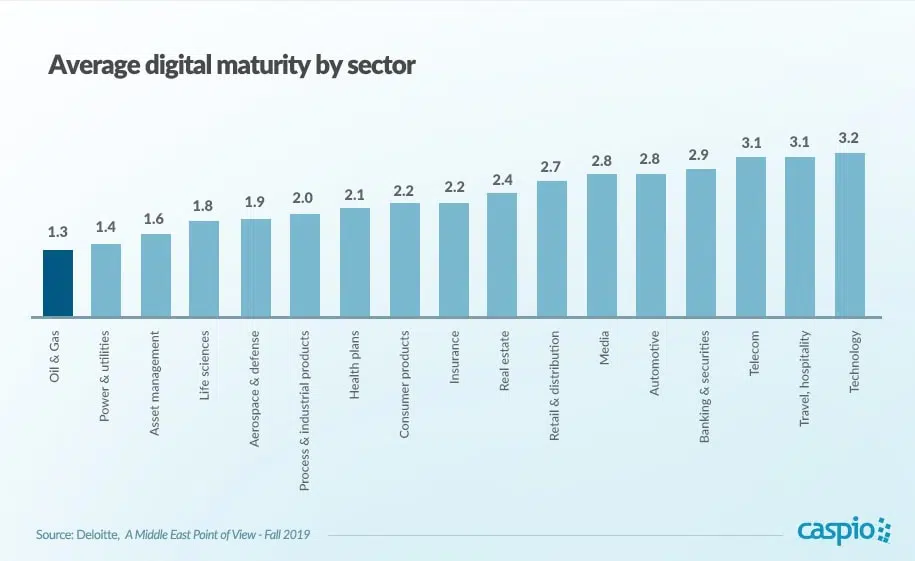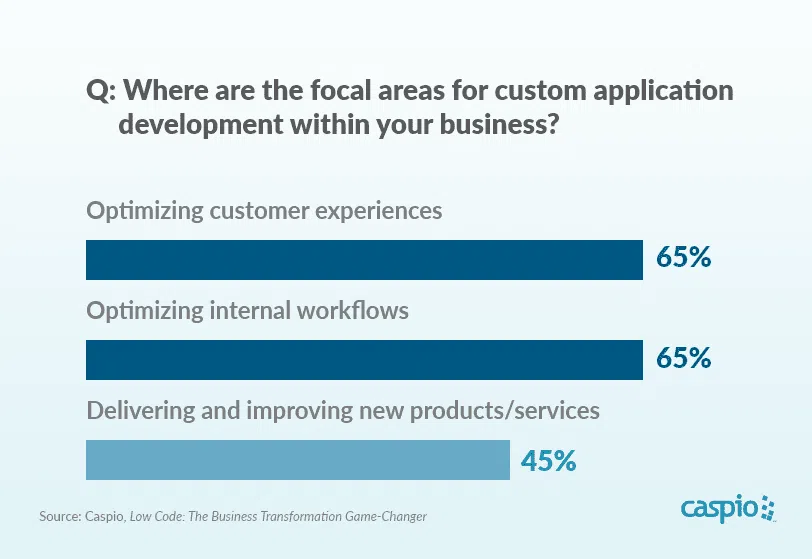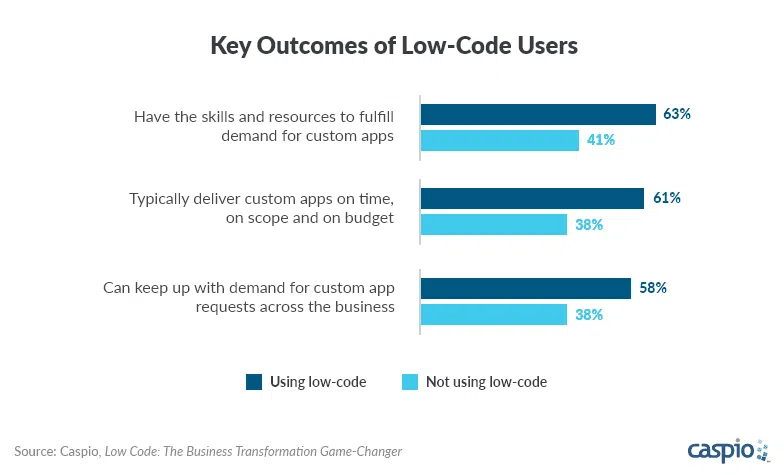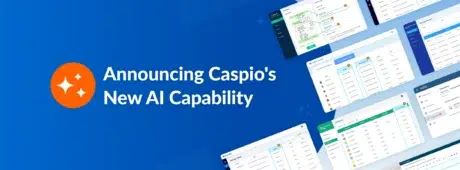Midstream Oil & Gas Companies: Digitally Transforming For a Bright Future
April 6, 2020

Summary:
- The oil and gas industry is being shaped by numerous risk factors, including supply and demand imbalance, rise of sustainable resources, higher operating costs and increased pressure from investors.
- As competition becomes tougher, midstream businesses must improve data management and integrate digital technologies within their operations.
- The sector is lagging behind other industries in terms of digital maturity.
- Developments in technologies, such as cloud and low-code, are driving trends that have massive potential for the midstream sector.
- Incremental changes alone are not sufficient to unlock the full potential of digital — transformation must encompass technology, people and practices.
- Midstream companies, as well as other businesses in the larger oil and gas ecosystem, have started leveraging Caspio’s low-code technology to digitally transform, making their operations fast and efficient.
The Midstream Oil and Gas Sector is at an Inflection Point.
Depressed oil prices caused by overproduction remain a major concern amid weakened demand. To address this imbalance, oil and gas companies are poised to implement a reduction in supply in 2020, according to the International Energy Agency.
This comes at a time where more and more people are starting to lean towards sustainable resources, such as wind and solar power.
Even technology leaders like Bill Gates are supporting the green cause. Late last year, a startup backed by the Microsoft founder has reportedly created a solar oven capable of reaching temperatures high enough to power industrial processes — a development that could potentially replace fossil fuels at steel and cement manufacturing plants.
But that’s not all.
Midstream players are also struggling with higher operating costs, a decline in skilled workforce and heightened pressure from investors. The bottom line? Digital transformation has become a strategic imperative of critical importance for midstream business leaders.
How Digitally Mature is the Oil and Gas Sector?
According to Deloitte, the oil and gas industry is in last place when it comes to digital maturity. Although known for utilizing advanced tools and machinery at the core of their operations, the sector has fallen behind in terms of leveraging real-time insights and data.
In other words, they have not fully digitally transformed. The industry is losing trillions of dollars in potential revenue as a result, according to the report.

How Midstream Companies Can Digitally Transform
Competition among midstream players is only getting tougher.
To remain profitable in challenging times, a shift in mindset is necessary, particularly in how to maximize data and digital technologies. Here’s how to start fully embracing digital.
Retool the organization with digital capabilities.
Digital solutions provide a wide array of benefits, from centralizing operational views to streamlining processes, cost models and organizational structures.

Yet, the majority of oil and gas entities still rely on legacy systems in dealing with today’s supply and demand disruptions.
According to a study by Accenture, as much as 82% of players are not ready to let go of traditional tools just yet. On the contrary, digitalization holds the potential to generate approximately $100 billion of value for midstream companies and up to a trillion dollars for the entire oil and gas industry within the current decade, according to World Economic Forum estimates.
Midstream companies must embrace change and evaluate modern tools and concepts that increase digital capabilities, including custom software applications for specific workflows.
Develop a more agile approach.
Today, agile methodologies are not just tools for efficient project management; they are a driving force in the digital transformation of businesses.

While agile practices enable organizations to align the business with newly adopted technology, they must also empower employees with new skills and encourage them to evolve with the company.
To create agile business models that maximize digital’s full potential, midstream businesses must:
- Start small before going big. Start by using new systems to improve efficiency or productivity in specific domains or departments. Make sure they work before thinking holistically and developing a roadmap for the entire company.
- Rethink processes. Reimagine how goals are achieved within the institution. Think of new ways to solve complex problems that cut across organizational silos.
- Make changes stick. Pair digital investments with investments in culture, resources and people, allowing for a collaborative and experimental environment.
Leverage better data management.
The midstream sector, in particular, has been collecting massive amounts of data — from pipeline apps and SCADA to ERP systems — even before the term “industrial internet of things” (IIOT) was coined. A drilling rig alone yields terabytes of data daily.
However, only 2% – 10% of the data being generated is processed and analyzed to drive operational improvement, as reported by the Oil & Gas Journal.

Midstream companies that want to digitally transform must get better at making data more accessible to decision-makers instead of just storing it in disparate systems. Making data-driven decisions starts with effective data gathering and management.
Clear Digital Chokepoints With Low-Code Development
Companies know that unlike years ago, they cannot rely on enterprise and SaaS solutions alone to manage data and automate workflows; they now need to include custom business software in the mix.
In Caspio’s Low Code: The Business Transformation Game-Changer report, we found that 93% of executives consider custom business applications as strategic enablers for their companies. They understand that these apps drive revenue and are a critical success factor in today’s highly competitive digital arena and information-based economy.

Despite buy-in from senior leadership, delivering business software and other digital transformation solutions becomes challenging for midstream companies, partly due to the massive burden it loads on the shoulders of the IT group.
The provision of tools for increased digital capability and proper data management, in particular, falls within the scope of IT. Unfortunately, 65% of businesses report the lack of IT talent and budget as top challenges when it comes to building and supporting custom business applications.

What can you do to further digital initiatives in your company if you’re facing similar challenges?
Midstream businesses that want to increase digital capabilities, adopt an agile approach and leverage better data management must evaluate the feasibility of “low-code” development for their organization.
Low-code is a development approach that enables users to create software faster and without having to write code. With low-code, organizations expand their “IT resources” by empowering business professionals — the people who will actually use the tools — to create their own digital solutions.

Our research shows that businesses using low-code have greater success in keeping up with the demand for application requests across the business. They typically deliver custom apps on time, scope and budget.
Low-code empowers businesses to replace inefficient legacy systems with powerful applications without hiring additional IT resources. With more digital applications, you’ll be able to optimize operational responsiveness, maximize savings and streamline complex processes.
How Caspio Fuels Digital Transformation for Energy Firms
With an ever-growing amount of data, midstream companies face the challenge of converting that data into actionable insights. You need real-time access to information to quickly respond to changes in the market.
Caspio addresses this challenge by providing energy companies with a low-code development platform that enables better data management and agile practices, all while empowering non-developers to build digital solutions without coding.
J-W Power Company, which operates the largest privately owned CNG compression fleet in the country, used Caspio to augment their short-staffed IT team and address the growing demand for digital capability tools within their organization.
Due to movements within the natural gas industry, J-W Power weathered divestitures and workforce adjustments over the years, especially in their IT department. Paul Woolsey, the company’s applications manager, started evaluating low-code platforms and found Caspio.
Within six months, Woolsey and his team built and deployed 15 applications using Caspio’s low-code database platform, all without hiring additional IT staff.
“Caspio hit all the sweet spots. As far as recommending it to others, peers and colleagues, I could not recommend it enough,” Woolsey said.
Aside from J-W Power, other companies in the larger ecosystem of the oil and gas industry have maximized Caspio’s low-code technology to embrace digital transformation.
Texas-based Chemily Information Management manages the accounting data of numerous oil and gas operators. They previously struggled in providing users with access to vital billing information online.
By fully integrating Caspio into their website, Chemily now provides thousands of users with secure online access to their bills.
“We tried other programs but Caspio was easy to use. I didn’t have to train my staff or do anything other than just adapt to the program,” controller Veronica Vela shared.
On the logistics front, GEFCO UK offers integrated solutions from its 80 hubs spread across 39 countries. As a global organization, they serve clients in a wide range of industries, including oil and gas.
IT solutions manager Simon Verdon needed a secure, multi-user central database to clear their invoicing and collection backlog. Using Caspio, GEFCO UK reduced invoicing time from 13 weeks down to two weeks.
They eliminated numerous spreadsheets with Caspio’s secure and centralized online database, effectively streamlining their processes and requiring fewer personnel to manage a bigger business.
“In terms of return on investment, Caspio has more than paid for itself,” Verdon said.
Start Digital Transformation in Your Midstream Business Today
For midstream companies, becoming capital-efficient is a must.
Fully embrace digital transformation by retooling your organization with digital capabilities — this is exactly what Caspio offers.
With Caspio, you gain access to a low-code platform to build digital tools faster and without taxing your IT team.
Start building online dashboards that show real-time financial performance and production data. Create service request trackers or dispatch systems for your field personnel. Improve customer support and experience with ticketing systems and escalation workflows. Empower your sales and marketing teams with a custom CRM and productivity analysis tool.
Maybe start with a free database and migrate your data to the cloud first.
By using low-code, you’ll be able to start small but fast.
Build only the critical functions you need, and then improve the application iteratively with user feedback. This speed of development provides you with the agility to respond to the digital needs of your business.
Aside from our technology, use Caspio to promote digital transformation in people. By empowering business professionals to build their own applications, you’re creating a digital culture not just within the walls of IT but across the entire organization.
By promoting digital through technology, people and processes, you’re setting up your midstream company for a brighter future.
Want to learn more on how your midstream oil and gas company could go digital using low-code technology?
Schedule a free consultation with one of our experts and see how you can make it happen with Caspio.


















